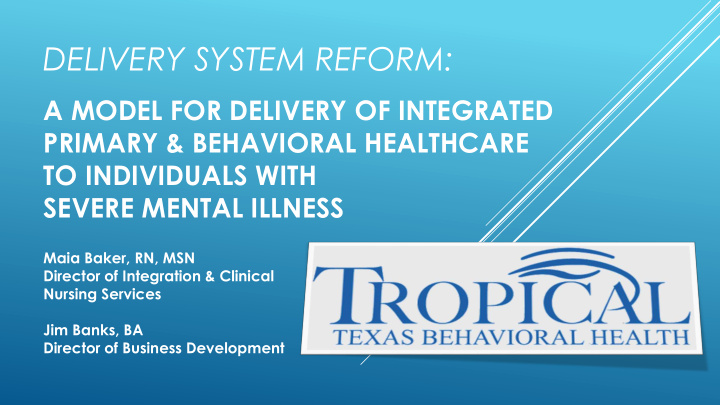



DELIVERY SYSTEM REFORM: A MODEL FOR DELIVERY OF INTEGRATED PRIMARY & BEHAVIORAL HEALTHCARE TO INDIVIDUALS WITH SEVERE MENTAL ILLNESS Maia Baker, RN, MSN Director of Integration & Clinical Nursing Services Jim Banks, BA Director of Business Development
PROBLEM Many TTBH clients have chronic and co-morbid conditions including hypertension, diabetes, and obesity Unable or unwilling to seek Primary Care services 40% of premature mortality is caused by behavior (New England Journal of Medicine: We Can Do Better: Improving the Health of the American People, Sept. 2007). Physical and behavioral health are interdependent Belief that care for the whole person is integral to healing
OPPORTUNITIES Establish primary care clinics within TTBH behavioral health clinics Provide primary care services to TTBH clients with co-morbid chronic disease using an integrated approach to care Improve the Health, Wellness, and Life Expectancy of the SPMI population served
INTEGRATION STRATEGY “Reverse Co - location”, Bi -Directional model Employ a team of primary care professionals to staff clinics within 3 TTBH clinics 2 of the 3 clinics funded by DSRIP
STAFFING Behavioral Health Services Primary Care Services • Psychiatrist or mid-level • Primary care physician or mid-level • RNs, LVNs • Chronic Care RNs • LPHAs • LVNs, CMAs, CNAs • QMHP/Case Managers • Registered Dietician • Peer Staff • Care Co-coordinator • Support Staff, PAP clerk • Support Staff, PAP clerk
STRENGTHS Commitment to organizational transformation Integration Champions Single Electronic Health Record Single Patient Centered Recovery Plan Warm Hand-offs Continual bi-directional communication Plan to integrate new SUDs OP services
STRENGTHS All pieces of care provision puzzle under the same roof & administrative umbrella: • Decreased treatment non-compliance (BH and PC) • Administrative communication • Policies & Procedures • Accreditation
PRIMARY CARE DSRIP PROJECTS 1. Integrated Primary and Behavioral Health Care 2. “In - House” Medical Clearances 3. Chronic Care Management
DATA CAT 2 METRICS CAT 3 OUTCOMES ► UNIQUE CLIENTS SERVED Diabetes Care: HbA1c Poor Control (> 9.0%) ENCOUNTERS Controlling High Blood DISEASE SELF- Pressure (< 140/90) MANAGEMENT GOALS Visit Specific Satisfaction FREQUENCY OF CQI (VSQ-9) ACTIVITES
CATEGORY 2 METRICS 2000 1500 UNIQUE CLIENTS 1000 1770 1769 SERVED 1000 500 700 0 DY4 DY4 DY5 DY5 TARGET ACHIEVED TARGET ACHIEVED ACCESS TO INTEGRATED PRIMARY CARE
CATEGORY 2 METRICS 500 400 UNIQUE 300 CLIENTS 438 SERVED 200 307 300 100 100 0 DY4 DY4 DY5 DY5 TARGET ACHIEVED TARGET ACHIEVED “IN - HOUSE” MEDICAL CLEARANCES
CATEGORY 2 METRICS 1000 800 UNIQUE 600 CLIENTS 966 SERVED 800 400 737 400 200 0 DY4 DY4 DY5 DY5 TARGET ACHIEVED TARGET ACHIEVED ACCESS TO CHRONIC CARE MANAGEMENT
CATEGORY 2 METRICS 8000 6000 ENCOUNTERS with 7901 4000 CHRONIC CARE NURSE 4920 2000 3000 2750 0 DY4 DY4 DY5 DY5 TARGET ACHIEVED TARGET ACHIEVED ACCESS TO CHRONIC CARE MANAGEMENT
CATEGORY 2 METRICS 100% 80% CLIENTS with 60% SELF- 96% MANAGEMENT 81% 40% GOALS 60% 55% 20% 0% DY4 DY4 DY5 DY5 TARGET ACHIEVED TARGET ACHIEVED ACCESS TO CHRONIC CARE MANAGEMENT
CATEGORY 3 OUTCOMES 100.0% 80.0% CLIENTS 60.0% with 94.5% 88.4% HbA1c >9.0% 40.0% 50.7% 48.5% 47.6% 20.0% 0.0% DY3 DY4 DY4 DY5 DY5 BASELINE THRESHOLD ACHIEVED THRESHOLD ACHIEVED HBA1C POOR CONTROL (> 9.0%)
CATEGORY 3 OUTCOMES 100 80 OVERALL 60 AVG 98.86 91.34 SATISFACTION 82.07 81.08 80.08 40 SCORE 20 0 DY3 DY4 DY4 DY5 DY5 BASELINE TARGET ACHIEVED TARGET ACHIEVED VISIT SPECIFIC SATISFACTION (VSQ-9)
CATEGORY 3 OUTCOMES 100.0% 80.0% CLIENTS 60.0% with BP < 140/90 40.0% 60.4% 59.3% 58.2% 57.5% 54.3% 20.0% 0.0% DY3 DY4 DY4 DY5 DY5 BASELINE TARGET ACHIEVED TARGET ACHIEVED CONTROLLING HBP (< 140/90)
OUTCOMES 44% of clients receiving integrated PC services had a decrease in BMI Decrease in BH treatment non-compliance as clients report wanting to maintain primary care services.
CHALLENGES Integration of medical model service into a well- established behavioral health system/culture Recruitment & Retention of qualified, culturally competent clinicians Maintaining Practice Consistency Need to expand array of available primary care services
CHALLENGES Growing demand for primary care to uninsured with SPMI Availability/costs/funding for specialty resources/consultations Value to MCO’s unknown Quantifying data across systems Costs & Sustainability
SUSTAINABILITY Revenue generation: • Legislation to expand Medicaid for SPMI population • Negotiating with MCOs - Include primary care in Managed Care contracts Alternative funding sources: • Recent 501(c)3 designation • Sí Texas: Social Innovation for a Healthy South Texas • Local Support – Valley Baptist Legacy Foundation Keys: • Outcome data – Supporting efficacy of our integrated care model for the target population • Evaluation rigor - Sí Texas project
CQI & FIDELITY Weekly: LOC 3 Case Staffings Monthly: • Integration Workgroup - BH and PC clinical directors, program managers and supervisors • Integrated BH and PC Case Conferences - Discuss uniquely complex/challenging cases • 1115 Waiver Performance Improvement Committee - Monitor progress with DSRIP metrics, Cat 3 outcomes, and core components
NEXT STEPS Continued emphasis on BH and PC clinicians endorsing collaborative and coordinated care Evaluate results of PHQ 9 assessments(6th vital sign) of patients receiving integrated care Data sharing & quantifying impacts across systems Expansion of primary care resources/services
QUESTIONS?
Recommend
More recommend